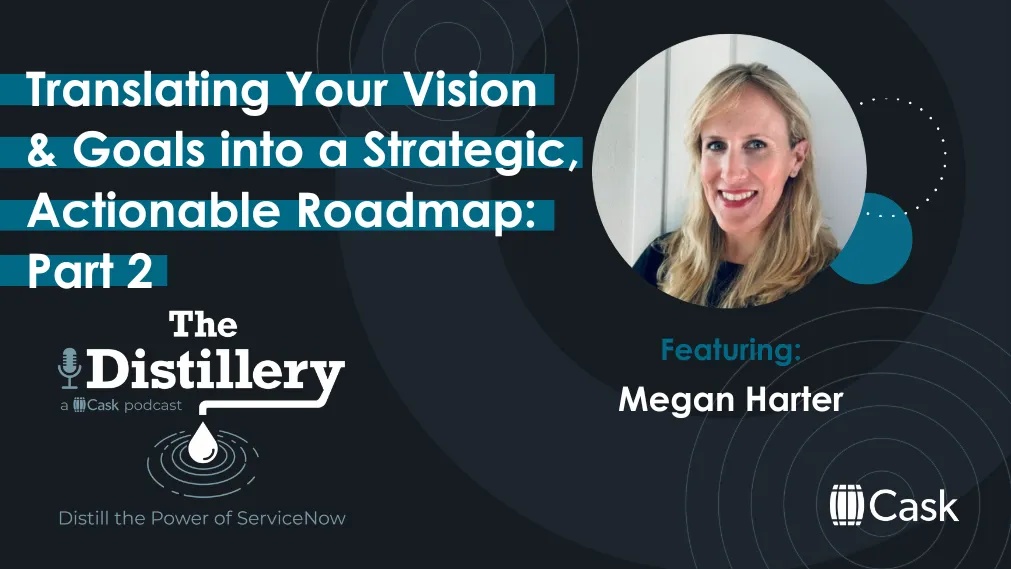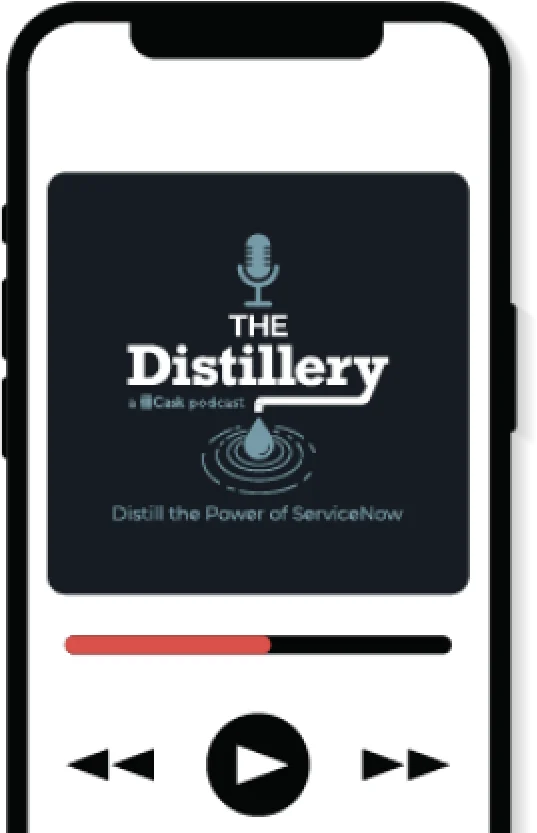Your Host:
Sean Dawson
Our Guest:
Megan Harter

In this follow-up discussion, Megan Harter and Sean Dawson map out how to drive business value with ServiceNow. Megan provides tips on stakeholder engagement, capturing pain points, and building roadmaps. She stresses the importance of flexibility—roadmaps can start small and evolve over time. Megan and Sean also discuss the pros and cons of in-person versus remote workshops when creating strategic alignment. Tune into this insightful discussion to learn how ServiceNow can help you realize business goals through strategic roadmapping.
Tips and tricks for roadmapping
SEAN DAWSON: I want to step back and talk a little bit more about maybe some actionable things and some tips and tricks, if you will. Like how—you know, we—I had mentioned organizational change management. But do you have any tips or tricks on how to bring an organization along with this? Or maybe someone’s—I don't know—it could be an enterprise architect or someone that's higher up enough to look at this. But do you have any recommendations from what you've seen in the field while you're doing this of how to get organizations to come along with this?
MEGAN HARTER: Sure. Understanding the impact, I think. And if you can show people within an organization that you're going to solve problems that they are living on the day-to-day, they're somehow—you're somehow gonna make their life—their work life—better. Whether it be they’re swivel-chairing from one system to another or they're working on, you know, components of a process that are, you know, just repetitive or something that potentially could be automated, and it's just taking a ton of time, or they're doing manual data scans where something could be scripted, right?
Helping understand, “Hey, when this piece of work is done and I'm gonna learn something new, these are the problems we're trying to solve.” You know, you talk to your coworkers and like, gosh, there's always something about the organization, right, that people want to complain about, right?
And if you take the time to do this roadmapping up front, and you listen to the people that contribute to your, kind of, analysis as you're going through and figuring out what you wanna fix or target for maturation, right? If you tell those same people, “Hey, we've listened to you, and these are our priorities too,” it's really hard for them not to get excited, you know, that you're trying to make momentum across something that they found to be inadequate or that they thought could be better.
And I have found that passion across that one—it's like, “Hey, this is my idea,” or, “My leadership actually cares about my day-to-day job,” or, “They want my life to be more positive at work.”
It's really hard not to get buy-in in that capacity. I mean, I know sometimes through project work can feel difficult because you have people kind of doing project work and day-to-day work at the same time. But hopefully they are championing that to their peers as well, and that infectious anticipation kind of spreads as you're going.
Sean: I've seen that with IT. Actually, you know, in customers, like, as soon as they start talking to a business unit or a business group, they're like, “Oh, IT is trying to take it over again.” And what you're talking about is getting their buy-in and showing you're trying to be a partnership, because IT really is no longer a silo of just technical stuff. It intertwines into everything. So there's great tips in that.
Tools to use when roadmapping
SEAN: So from an actionable standpoint, what I wanted to talk about next is, I know sometimes listeners out there can get stuck on the tech behind the roadmap. And what I mean by that is, you know, there's tools that we use. I know that you use tools. I use tools for what we're doing, but I thought maybe give a little section—which, we’re normally very high-level on the podcast—but I thought, gosh, why not feed what we're trying to do here and what are some of the tools that we use?
So somebody's like, “Oh, well, I can't use a Post-it note. That's not good. I can't use a napkin. I gotta use whatever. I gotta use Illustrator. I gotta go buy a Creative Cloud, you know, subscription or something like that.”
What are you using, Megan, to find, you know, have the most flexibility? And what have you seen used besides what you use?
MEGAN: So, that's funny. I mean, quite honestly, what I use most to kind of gather my thoughts is Post-it notes. I take copious notes during an interview session, right? I like to call it “corporate therapy.” You know, like, “Tell me all your problems, tell me what you want.” And then I always end with, “If I was a genie, right, and I could grant you three wishes within your organization, what would those things be?” And I write those down, each one on a Post-it note. And I put them all up on my whiteboard in my office.
And as I'm going through, you can start to group those, right? You can start to see commonalities and themes emerge from those different things. Maybe they are worded slightly different. But, you know, I really start with kind of just that rudimentary, like, “What am I even looking at?” Before I can put it into some fancy piece of technology, I need to be able to kind of organize my mind.
And for me, personally, I like to write things down. I kind of see patterns a whole lot more when it's just written down in front of me than I do when it's in technology. At that point, I really like Lucidspark and Lucid to take some of those back to a customer and kind of do that digital Post-it note exercise and show them, right? Like, the themings that we've come up with, and this is kind of how we've mapped it out. You know, and see if that resonates with them as an organization.
What's great about that is that you don't have to be in person. You can do that from Zoom, and you can do those little digital Post-it notes and just kind of move things around and really have that kind of interactive experience to kind of theme things out and put them together. To build out my roadmaps, I really like PowerPoint and just kind of building them out manually and kind of understanding that.
But then, from a ServiceNow perspective, right, there's the portfolio alignment planner that can be a really great tool with this. And we work with a customer that has that. It's great to put their whole roadmap in that strategic alignment planner—I think now ServiceNow calls it the portfolio alignment planner or portfolio planner—and putting that in there. And then being able to kind of map that journey utilizing the ServiceNow platform is good, but you don't have to have expensive technology and tools to be able to build something like this out. You can have a pen and paper, maybe some Excel, and probably a PowerPoint to be able to put your thoughts together, and you can still be vastly successful in that component.
So you don't need to let technology hinder your success or desire to really get started on something.
Sean: Yeah. What a great response. Thanks for that. I mean,
Remote vs. on-site
SEAN: I have one last question, is: Remote or on-site? Now, I know there's benefits to both. Some orgs can't, you know, do both. But I gotta be honest, there's times where I've been on-site and it made all the difference, especially for something like this. But I was curious on your thoughts. What have you seen in the marketplace when you're doing these? Do you recommend remote, on-site, or both, or whatever works for the company? What are your thoughts?
Megan: Ideally, it's great to be able to get a group of people into a conference room for a few hours and really strategize something. I think the pandemic taught us that what we thought was necessary wasn't, right? And that we all learned that we could do good work in a remote capacity.
But there's something about the relationships that you build with people when you're sitting in a room with them or maybe go out for a drink or dinner afterwards and start building that personal connection so that you can understand and truly partner with the people that you're working with. If you don't have that, you're only working at the business level, and sometimes that can be fine. But to truly make something exceptional or a relationship long-term and, “Gosh, I really wanna work with this person,” right, you wanna know something about them personally. And sometimes that's hard to get via only, you know, digital means. But certainly, if that's what's available to you, it—
I guess the key message is, ”Don't let technology or logistics hold you back from trying something.” You can always make something work, and the ideal state could be what it is for you and your organization. But, you know, just try and keep trying. Keep going back to the well, and you'll find there's many different ways to do things. Cask has several, you know, tools in the toolbox in this capacity and different approaches. And if we see something that's not working, we try something else, and we're constantly going back to that to make sure that for the specific situation we're in that we're doing the right things, right?
So, again, just to answer your question, in-person is super, but digital or virtual is certainly something that can work across the board.
Sean: Yeah. Great, great.
Start small
SEAN: So Megan, I've got one last question for you, and it's gonna be surrounding like, did I miss anything? Did we miss anything in the questions? Something else you would like to share with our listeners on the podcast that would be valuable.
Megan: Sure. I think, you know, when you hear the term “strategic roadmapping” or, you know, “business value,” it may feel intimidating, that maybe you need to be a really big organization or have, you know, a really high-profile name or, you know, GE, or Kelloggs, or, you know, Zion's Bank Corporation, right?
But you don't need to have a high-profile industry placement to be able to make a difference in your organization. You can start small. You can work into something that's long-term, even if it's very small pieces. And a small group of people can do really, really good things. And if you can find a great partner to kind of help you with that, they can supplement in areas where you might have gaps from a resourcing perspective.
But don't let the thought, you know, that “Maybe we're not big enough” or “We can't be strategic because, you know, we're maybe new at all of this,” like, it's OK. You can grow and mature that roadmap as you go and it's never done, it's never finished. It's not written in stone. You can always change it. You can always go back to it and meet your organization where it is right then.
And that could be your organization grows, or maybe your organization gets smaller, and you have to go ahead and, you know, revise what it is that you're looking at. And it's just really important to keep in your mind that you don't have to be perfect, and don't let good enough or an MVP approach get in the way of something that could be, you know, just exactly what your organization needs.
And that intimidation factor can really get in the way. And just have confidence in yourself and your organization and your peers—and likely you'll find success in some capacity.
Sean: Yeah, you're kind of reminding me of, if you're, you know, if you're a small organization and, I don't know, single admin or platform owner, you get a little bit of an imposter syndrome.
Again, we call these things—and you said it earlier is—these things are movable. They're changeable. They're flexible. You can't do it wrong. And we actually use a term here here at Cask and, at least, for I know, for most of our timelines or, I'm sorry, our strategic roadmaps, we call them “notional” because they can move, they can change. So that's such a great point, Megan. Thank you.
And that's it for our podcast today. But Megan, thank you so much for joining us and the insights you brought. I'm sure people are gonna get a lot of value out of this, and I just wanna thank you so much for your time. It was great.
Megan: Thanks, Sean, for having me. It's been great.
Sean: All right. Take care.
Megan: Bye bye.
We’re with you for what comes next
You're working in a rapidly shifting environment.
Global dynamics, AI advancements, heavy competition–the only certainty is change.
We get it. And we’re here to help you harness the full potential of ServiceNow to simplify transformation.
Let's navigate the future together.

Recent Episodes
We’re with you for what comes next
You're working in a rapidly shifting environment.
Global dynamics, AI advancements, heavy competition–the only certainty is change.
We get it. And we’re here to help you harness the full potential of ServiceNow to simplify transformation.
Let's navigate the future together.

Let’s Innovate Together!
Request a Complimentary Consultation from Cask.
Cask’s unparalleled expertise is ready to tackle your unique challenges and transform your aspirations into reality. We’ll listen to understand your requirements and offer a tailor-made approach that aligns with your strategic objectives.
Your journey to innovation is just a click away. Schedule your meeting with our Cask advisors and become part of the success story that defines your organization’s future.

Sign up for our Distillery Podcast
Stay up to date with the latest episodes







